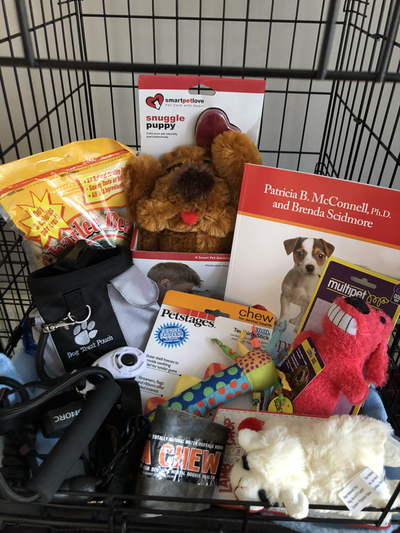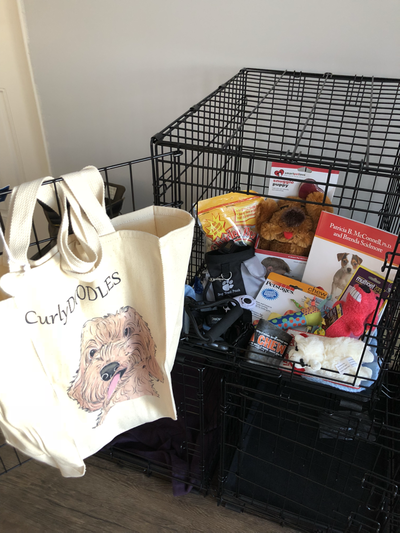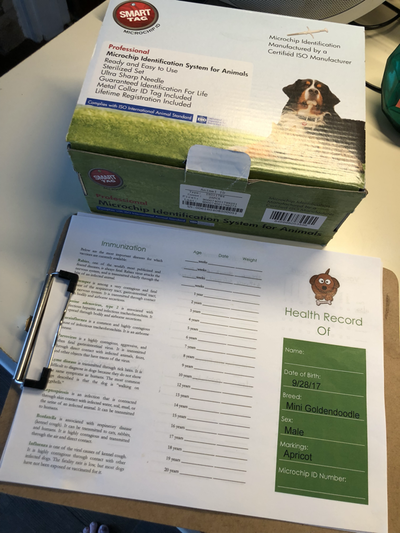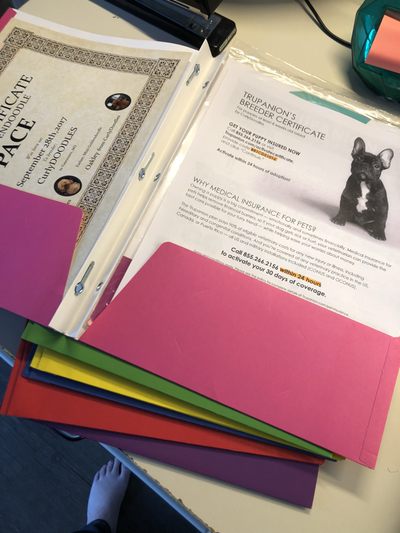Pick up day is a big day. It’s exciting and overwhelming. This information should help you feel more prepared.
Feeding
Your pup will be eating both kibble and raw when they leave. You can select which you prefer to continue. Feeding is 3 times a day if possible. If not, 2 will be fine. Start with 1 cup of kibble or for raw 10% of body weight a day divided by number of meals. If you are feeding raw, please educate yourself with books provided. I feed a premix balanced diet of bone organ and meat. Additionally, I rotate proteins and I also use NuVet vitamins. With any diet, you need to watch puppies body to determine if you are over feeding or under feeding. To defrost raw, place the tube in the refrigerator the day before. It should be semi defrosted by the next day for feeding. Do not cook or heat up. And it only lasts in fridge about 3 days before it sours. You can make your own meals. I recommend joining a good fb group and reading as much as you can before you decide to make your own meals. If feeding kibble you can continue the turkey sweet potato or chicken oatmeal or chicken sweet potato. All 3 are very small sized kibble and work great for new puppies. I always tells families ultimately its your choice on what you want to feed. I feed kibble and raw because after years of search nothing ever checked all the boxes other than these 2 options. I wanted a food that sourced ingredients in countries with high standards like the US. I did not want fish coming from china. I wanted it to be fresh. This kibble is manufactured and shipped to your door in 6 weeks. I wanted less poo. This food is dense so you feed much less of it and so less comes out the other end. I also wanted a food that was healthy. I didn't want a food with lots of recalls that I had to worry about. This kibble has no recalls on their food. Its a small company that pays attention to detail, not a huge manufacturer that produces several different qualities of food. Email me for name of company
Potty Training
Before your puppy comes home, you'll want to get some pee pads or you can purchase our go home puppy pack which will include pee pads. Place one pad at the exit door and this one will be used for 'oh my gosh I have to go' emergency. Take the pup out every hour awake, especially as soon as the puppy wakes up or after eating. The night time schedule I recommend for a few weeks is out at 10-11 pm, out at 2 am, then out at 5-6 am. I like potty bells and if you use them just take their nose and touch bells each time you exit door to potty. I also say command “go pee."
Crate Training
Crate training is so important because you never know in the future when you might need to board your dog or in case of some type of emergency and your dog needs to be contained. It's much better to crate them from the beginning so they are used to it and it's not sprung on them when they are older. In our go home puppy pack that you can purchase separately, we do include a small crate for them to get started. If you do not purchase the go home puppy pack, you will need to have a small crate that you purchase before your puppy comes home. You will need a larger crate later on. The small crate should last you a couple of months. I crate whenever I'm not home. You can also crate at night. If you are on the fence at all about crating, I highly recommend you do it at least for the first 6 months. They will cry first couple days. Use a command like “go sleep” and put a treat in crate along with a special toy like the snuggle puppy. Some people purchase a puppy playpen like I have and place the pup in the pen when they eat or can’t watch the pup. It will take your puppy some time to adjust to being alone and not having their siblings to share the pen/crate with. If you do not buy a crate or pen to keep your puppy in, always keep them confined in the same room you are in. They should not have free reign of the house. That will only create bad habits. You also can't redirect behavior if you aren't seeing it. If you can't contain them to the room you are in, you can also leash them to your belt loop. This is a very successful method to help with potty training.
Walking
Walking should be done on one side right beside you. I like the treat pouch and clicker to get them trained to do this. Use the clicker then command to stop and give treat. The more you walk, the more they will learn. Their hips are not developed at this young age. For the first 6 months, walk on grass whenever possible. No hiking or walking miles until they are adults. Short walks should only be done after all of their shots are up to date. In our go home puppy pack available for purchase, there is a harness, leash and sealtbelt.
Bowls
If feeding raw, use a stainless bowl. I like the 360 water fountain that can be purchased on Amazon. Amazon also has a couple other options like slop stopper that keep puppies from playing in the water bowl. Puppies are more sensitive to water than adult dogs. If you can use filtered water, I recommend you doing so. If your water isn't great, then buy bottled.
Vaccinations
Your puppy has already had their vet exam and vaccinations at 8 weeks. My vet recommends the next vaccination dose at 11 weeks then the final dose at 14 weeks. The first vaccination should not contain lepto. Lepto can be done at 16-17 weeks. You will also need to discuss with veterinarian if any other vaccinations are necessary for your lifestyle and area. I personally do all of the vaccinations, including lyme and kennel cough. Your puppy also was microchipped at their vet appointment. This microchip is registered for lifetime. You should have received an email to set up password for the microchip.
Flea and Heartworm Prevention
Your puppy did receive their first dose of revolution for fleas and heartworm prevention. I find that most vets will switch you to another product. I like revolution and feel like it is a very safe product. It does guard against parasites and ear mites; however, does not guard against ticks. My second choice is Bravecto at 6 months old, along with Heartguard. New products are constantly being introduced. Talk to your vet about what their preferences are and why.
Rehoming
If any point, your dog needs rehomed, it is important that you notify me first. I have first right of refusal per the contract.
Pet Insurance
Your puppy will be sent home with paperwork Trupanion pet insurance. Your pup is covered for 30 days and then you can decide if you wish to continue. This is personal choice; however, I highly encourage you to continue with some kind of vet insurance. If your pup eats a sock and needs surgery, it’s around $2,000 to do this.
Grooming
I highly recommend and love the Chris Christenson brush on Amazon. This is a good daily brush. A slicker brush pulls out under hair if your puppy is shedding or changing coats from puppy to adult coat. You can watch YouTube videos on how to pull hair up and brush from the shaft out in section. Length is definitely a personal choice and depends on your lifestyle. Some considerations to take into account - do you swim with your puppy? Do they get wet a lot? If so, you probably want to consider a shorter groom. If you're not great at brushing at least 3 times a week, then they will mat and you will need to groom shorter. Find a good groomer and make an appointment every 8 weeks. This will eliminate the need to shave the pup because of mats. When you go more often, it's easier on the groomer and cheaper. If you let them mat every time, expect to have your dog shaved and a hefty bill, plus it's extremely uncomfortable for your dog. Decide if you're trimming nails or having the groomer do it. They will need done at least once a month.
Car Riding
I highly recommend using a harness and seatbelt for car rides. Having them sitting on a seat and confined makes the drive much safer for everyone involved and encourages proper behavior in the car. Some young puppies can get car sick. They will usually outgrow this by 6 months. Just keep doing short rides and don't feed right before a car ride. You can also try cracking the window for fresh air.
Socialization
Socializing your dog is extremely important. After all of the vaccinations are completed, you can take your puppy to puppy training class. Other ideas include taking your puppy to a friend's house to visit, the park, or big box stores that allow dogs. Getting them used to going places and meeting people encourages good behavior. The first 6 months are critical in socializing. They should be introduced to new people, children, different places and flooring. The more you socialize, the more relaxed they become around strange things. We also highly recommend Baxter & Bella training with is an online service that you can do at home. You'll find the link at the bottom of this page.
Spaying/Neutering Your Puppy
At 6 months old, you need to make an appointment to spay or neuter your pup. You should not fix your puppy earlier than 6 months. Talk to your vet and find out their preference on when to perform this surgery. Some vets prefer to wait a little longer. If you decide you want to breed your dog, you MUST contact me to discuss first as part of your contract. I do sell breeding rights; however, if you breed without notifying me, I will have to resort to legal action for breech of contract.
Your Puppy Coming Home
Your puppy coming home will be a stressful time for the puppy. They no longer have access to their mom or siblings to comfort them. Remember, your pup is like an infant when they come home and you are the parent. What you teach them is what they will know. It is normal for them to cry when left alone at first. I know that most were taught not to hold a baby too much or you'll spoil them so you're supposed to let them cry. I personally don't like this method, especially during this adjustment period the first week. Pick them up and comfort them. By day 4-5, they are starting to get used to the schedule and adjust to their new life. It is okay at this time to let them cry a little in the crate. After they have adjusted to you, you can then become more strict with the crate.
Recap
Your puppy will come with vet paperwork that will be in a folder provided. Your puppy will also already have had revolution, along with age appropriate vaccinations and the microchip. We do have a go home puppy pack available for purchase for $200. This includes a small crate, harness, leash, seatbelt, food, toys, treats, scent blanket, snuggle puppy, benabone, water Buffalo horn and a tote to carry it. Please make sure that you have room in your vehicle for this if you do purchase it when picking up your puppy.
Please never hesitate to reach out with any questions or concerns. I'm always available to help - please call or send an email. At any point, if it's not working out or your life circumstances have changed, you will need to notify me first. I will be able to help you with your dog. I have no problem placing a dog that didn't work out or wasn't able to fit in your family circumstances if they changed.
Feeding
Your pup will be eating both kibble and raw when they leave. You can select which you prefer to continue. Feeding is 3 times a day if possible. If not, 2 will be fine. Start with 1 cup of kibble or for raw 10% of body weight a day divided by number of meals. If you are feeding raw, please educate yourself with books provided. I feed a premix balanced diet of bone organ and meat. Additionally, I rotate proteins and I also use NuVet vitamins. With any diet, you need to watch puppies body to determine if you are over feeding or under feeding. To defrost raw, place the tube in the refrigerator the day before. It should be semi defrosted by the next day for feeding. Do not cook or heat up. And it only lasts in fridge about 3 days before it sours. You can make your own meals. I recommend joining a good fb group and reading as much as you can before you decide to make your own meals. If feeding kibble you can continue the turkey sweet potato or chicken oatmeal or chicken sweet potato. All 3 are very small sized kibble and work great for new puppies. I always tells families ultimately its your choice on what you want to feed. I feed kibble and raw because after years of search nothing ever checked all the boxes other than these 2 options. I wanted a food that sourced ingredients in countries with high standards like the US. I did not want fish coming from china. I wanted it to be fresh. This kibble is manufactured and shipped to your door in 6 weeks. I wanted less poo. This food is dense so you feed much less of it and so less comes out the other end. I also wanted a food that was healthy. I didn't want a food with lots of recalls that I had to worry about. This kibble has no recalls on their food. Its a small company that pays attention to detail, not a huge manufacturer that produces several different qualities of food. Email me for name of company
Potty Training
Before your puppy comes home, you'll want to get some pee pads or you can purchase our go home puppy pack which will include pee pads. Place one pad at the exit door and this one will be used for 'oh my gosh I have to go' emergency. Take the pup out every hour awake, especially as soon as the puppy wakes up or after eating. The night time schedule I recommend for a few weeks is out at 10-11 pm, out at 2 am, then out at 5-6 am. I like potty bells and if you use them just take their nose and touch bells each time you exit door to potty. I also say command “go pee."
Crate Training
Crate training is so important because you never know in the future when you might need to board your dog or in case of some type of emergency and your dog needs to be contained. It's much better to crate them from the beginning so they are used to it and it's not sprung on them when they are older. In our go home puppy pack that you can purchase separately, we do include a small crate for them to get started. If you do not purchase the go home puppy pack, you will need to have a small crate that you purchase before your puppy comes home. You will need a larger crate later on. The small crate should last you a couple of months. I crate whenever I'm not home. You can also crate at night. If you are on the fence at all about crating, I highly recommend you do it at least for the first 6 months. They will cry first couple days. Use a command like “go sleep” and put a treat in crate along with a special toy like the snuggle puppy. Some people purchase a puppy playpen like I have and place the pup in the pen when they eat or can’t watch the pup. It will take your puppy some time to adjust to being alone and not having their siblings to share the pen/crate with. If you do not buy a crate or pen to keep your puppy in, always keep them confined in the same room you are in. They should not have free reign of the house. That will only create bad habits. You also can't redirect behavior if you aren't seeing it. If you can't contain them to the room you are in, you can also leash them to your belt loop. This is a very successful method to help with potty training.
Walking
Walking should be done on one side right beside you. I like the treat pouch and clicker to get them trained to do this. Use the clicker then command to stop and give treat. The more you walk, the more they will learn. Their hips are not developed at this young age. For the first 6 months, walk on grass whenever possible. No hiking or walking miles until they are adults. Short walks should only be done after all of their shots are up to date. In our go home puppy pack available for purchase, there is a harness, leash and sealtbelt.
Bowls
If feeding raw, use a stainless bowl. I like the 360 water fountain that can be purchased on Amazon. Amazon also has a couple other options like slop stopper that keep puppies from playing in the water bowl. Puppies are more sensitive to water than adult dogs. If you can use filtered water, I recommend you doing so. If your water isn't great, then buy bottled.
Vaccinations
Your puppy has already had their vet exam and vaccinations at 8 weeks. My vet recommends the next vaccination dose at 11 weeks then the final dose at 14 weeks. The first vaccination should not contain lepto. Lepto can be done at 16-17 weeks. You will also need to discuss with veterinarian if any other vaccinations are necessary for your lifestyle and area. I personally do all of the vaccinations, including lyme and kennel cough. Your puppy also was microchipped at their vet appointment. This microchip is registered for lifetime. You should have received an email to set up password for the microchip.
Flea and Heartworm Prevention
Your puppy did receive their first dose of revolution for fleas and heartworm prevention. I find that most vets will switch you to another product. I like revolution and feel like it is a very safe product. It does guard against parasites and ear mites; however, does not guard against ticks. My second choice is Bravecto at 6 months old, along with Heartguard. New products are constantly being introduced. Talk to your vet about what their preferences are and why.
Rehoming
If any point, your dog needs rehomed, it is important that you notify me first. I have first right of refusal per the contract.
Pet Insurance
Your puppy will be sent home with paperwork Trupanion pet insurance. Your pup is covered for 30 days and then you can decide if you wish to continue. This is personal choice; however, I highly encourage you to continue with some kind of vet insurance. If your pup eats a sock and needs surgery, it’s around $2,000 to do this.
Grooming
I highly recommend and love the Chris Christenson brush on Amazon. This is a good daily brush. A slicker brush pulls out under hair if your puppy is shedding or changing coats from puppy to adult coat. You can watch YouTube videos on how to pull hair up and brush from the shaft out in section. Length is definitely a personal choice and depends on your lifestyle. Some considerations to take into account - do you swim with your puppy? Do they get wet a lot? If so, you probably want to consider a shorter groom. If you're not great at brushing at least 3 times a week, then they will mat and you will need to groom shorter. Find a good groomer and make an appointment every 8 weeks. This will eliminate the need to shave the pup because of mats. When you go more often, it's easier on the groomer and cheaper. If you let them mat every time, expect to have your dog shaved and a hefty bill, plus it's extremely uncomfortable for your dog. Decide if you're trimming nails or having the groomer do it. They will need done at least once a month.
Car Riding
I highly recommend using a harness and seatbelt for car rides. Having them sitting on a seat and confined makes the drive much safer for everyone involved and encourages proper behavior in the car. Some young puppies can get car sick. They will usually outgrow this by 6 months. Just keep doing short rides and don't feed right before a car ride. You can also try cracking the window for fresh air.
Socialization
Socializing your dog is extremely important. After all of the vaccinations are completed, you can take your puppy to puppy training class. Other ideas include taking your puppy to a friend's house to visit, the park, or big box stores that allow dogs. Getting them used to going places and meeting people encourages good behavior. The first 6 months are critical in socializing. They should be introduced to new people, children, different places and flooring. The more you socialize, the more relaxed they become around strange things. We also highly recommend Baxter & Bella training with is an online service that you can do at home. You'll find the link at the bottom of this page.
Spaying/Neutering Your Puppy
At 6 months old, you need to make an appointment to spay or neuter your pup. You should not fix your puppy earlier than 6 months. Talk to your vet and find out their preference on when to perform this surgery. Some vets prefer to wait a little longer. If you decide you want to breed your dog, you MUST contact me to discuss first as part of your contract. I do sell breeding rights; however, if you breed without notifying me, I will have to resort to legal action for breech of contract.
Your Puppy Coming Home
Your puppy coming home will be a stressful time for the puppy. They no longer have access to their mom or siblings to comfort them. Remember, your pup is like an infant when they come home and you are the parent. What you teach them is what they will know. It is normal for them to cry when left alone at first. I know that most were taught not to hold a baby too much or you'll spoil them so you're supposed to let them cry. I personally don't like this method, especially during this adjustment period the first week. Pick them up and comfort them. By day 4-5, they are starting to get used to the schedule and adjust to their new life. It is okay at this time to let them cry a little in the crate. After they have adjusted to you, you can then become more strict with the crate.
Recap
Your puppy will come with vet paperwork that will be in a folder provided. Your puppy will also already have had revolution, along with age appropriate vaccinations and the microchip. We do have a go home puppy pack available for purchase for $200. This includes a small crate, harness, leash, seatbelt, food, toys, treats, scent blanket, snuggle puppy, benabone, water Buffalo horn and a tote to carry it. Please make sure that you have room in your vehicle for this if you do purchase it when picking up your puppy.
Please never hesitate to reach out with any questions or concerns. I'm always available to help - please call or send an email. At any point, if it's not working out or your life circumstances have changed, you will need to notify me first. I will be able to help you with your dog. I have no problem placing a dog that didn't work out or wasn't able to fit in your family circumstances if they changed.
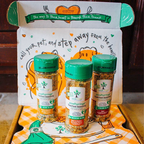
Pawtree: we highly recommend their food and paw pairings. Please use coupon code INTRO4U for your first order!
https://shop.pawtree.com//curlydoodles
https://shop.pawtree.com//curlydoodles
